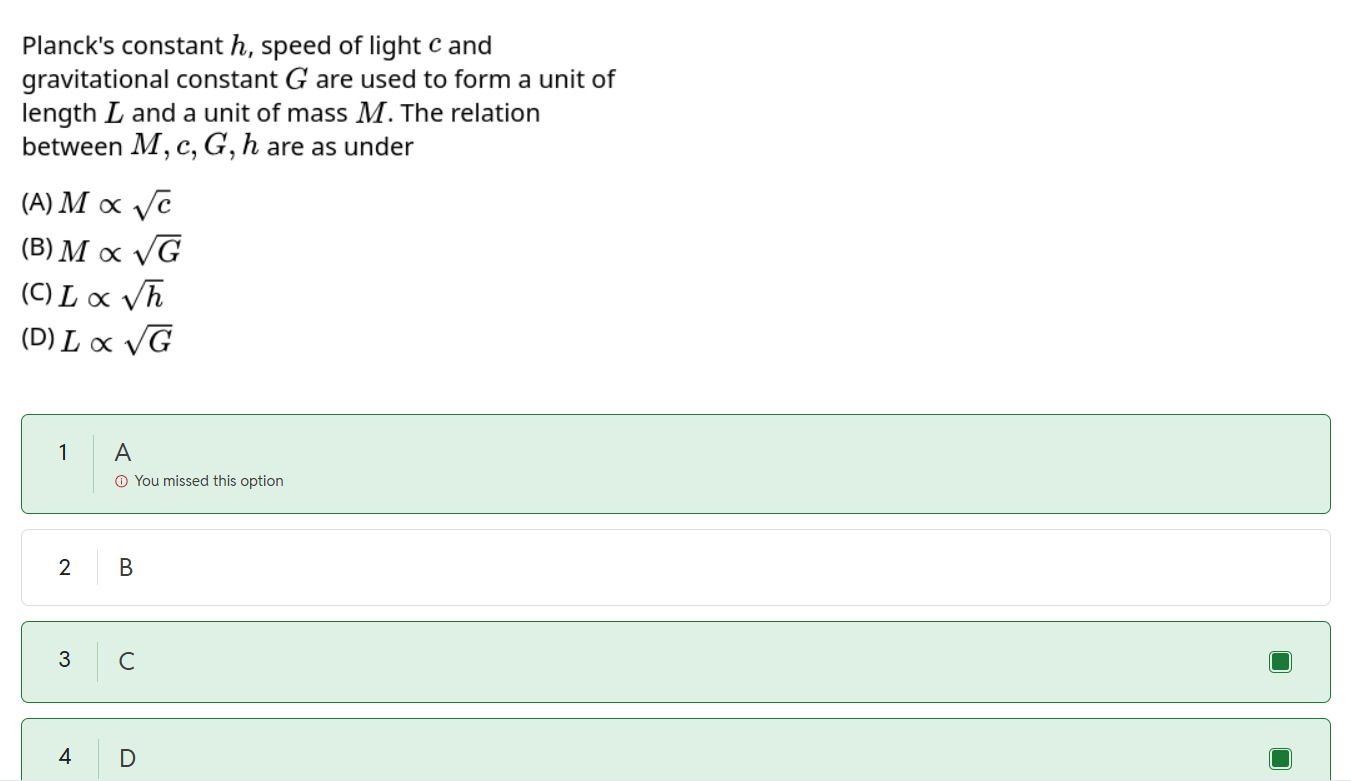Question
Question: Planck's constant $h$, speed of light $c$ and gravitational constant $G$ are used to form a unit of ...
Planck's constant h, speed of light c and gravitational constant G are used to form a unit of length L and a unit of mass M. The relation between M, c, G, h are as under

M ∝ c
M ∝ G
L ∝ h
L ∝ G
A, C, D
Solution
This problem can be solved using dimensional analysis. We are given Planck's constant (h), the speed of light (c), and the gravitational constant (G). We need to find the relations for a unit of length (L) and a unit of mass (M) formed from these constants.
First, let's determine the dimensions of the given constants in terms of Mass (M), Length (L), and Time (T):
- Planck's constant (h): Dimensions of energy × time. Energy has dimensions [ML2T−2]. So, [h]=[ML2T−1].
- Speed of light (c): [c]=[LT−1].
- Gravitational constant (G): From F=Gr2m1m2, we get [G]=[m1][m2][F][r2]=[M][M][MLT−2][L2]=[M−1L3T−2].
We assume that the unit of mass M and the unit of length L are formed by some combination of h, c, and G. These fundamental units formed from h,c,G are known as Planck units.
Let's find the expression for Planck mass (MP) and Planck length (LP). Assume MP=k1hxcyGz, where k1 is a dimensionless constant. The dimensions of MP are [M]. [M]=([ML2T−1])x([LT−1])y([M−1L3T−2])z [M]=[Mx−zL2x+y+3zT−x−y−2z]
Equating the exponents on both sides: For M: 1=x−z (1) For L: 0=2x+y+3z (2) For T: 0=−x−y−2z (3)
Adding (2) and (3): (2x+y+3z)+(−x−y−2z)=0⟹x+z=0⟹x=−z. Substitute x=−z into (1): 1=−z−z⟹1=−2z⟹z=−1/2. Then x=−z=1/2. Substitute x=1/2 and z=−1/2 into (3): 0=−(1/2)−y−2(−1/2)⟹0=−1/2−y+1⟹y=1/2.
So, the Planck mass is proportional to h1/2c1/2G−1/2. MP∝Ghc.
Now let's find the Planck length (LP). Assume LP=k2hacbGd. The dimensions of LP are [L]. [L]=([ML2T−1])a([LT−1])b([M−1L3T−2])d [L]=[Ma−dL2a+b+3dT−a−b−2d]
Equating the exponents on both sides: For M: 0=a−d⟹a=d. For L: 1=2a+b+3d. For T: 0=−a−b−2d.
From the T equation, b=−a−2d. Substitute a=d: b=−d−2d=−3d. Substitute a=d and b=−3d into the L equation: 1=2d+(−3d)+3d⟹1=2d⟹d=1/2. So, a=d=1/2, and b=−3d=−3/2.
The Planck length is proportional to h1/2c−3/2G1/2. LP∝c3hG.
Now let's examine the given options: (A) M∝c From MP∝Ghc, we can write MP=KMGhc. Thus, MP is proportional to c. This statement is correct.
(B) M∝G From MP∝Ghc, we have MP∝G−1/2, which means MP is inversely proportional to G. This statement is incorrect.
(C) L∝h From LP∝c3hG, we can write LP=KLc3Gh. Thus, LP is proportional to h. This statement is correct.
(D) L∝G From LP∝c3hG, we can write LP=KLc3hG. Thus, LP is proportional to G. This statement is correct.
